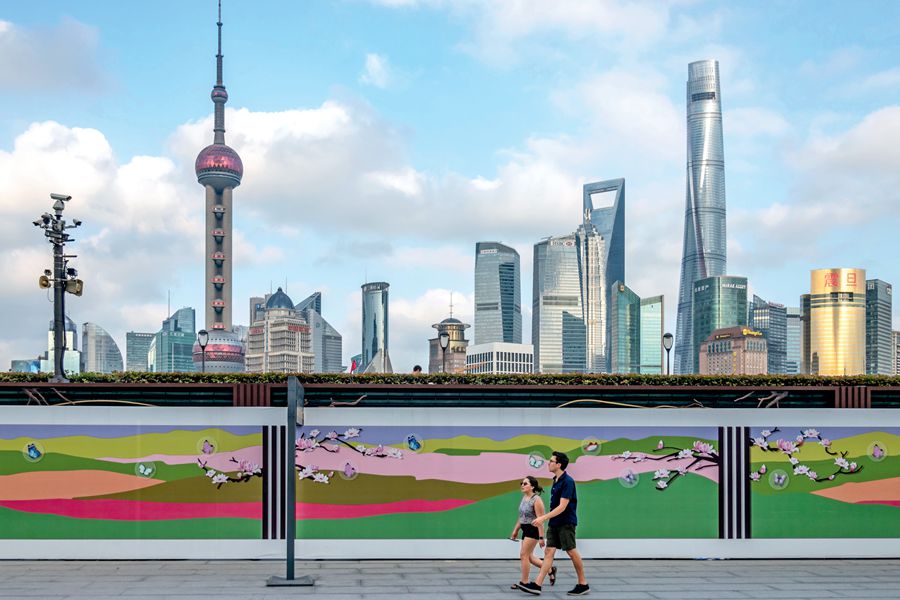LAST year, China celebrated the 40th anniversary of its reform and opening-up, which led the country on an unprecedented road to success. Thanks to that policy, China has developed in four decades from, in many respects, a backward third-world country, into one of the world’s leading economies.
Today, benefiting from these reforms, Chinese people have become wealthier, and the Chinese government will undoubtedly achieve its self-declared goal of building a moderately prosperous society in all respects by the year 2020.
The development that China has achieved since its reform and opening-up kicked off is breathtaking. The path China has taken is unique.
Forty Years of Evolvement
In the late 1970s, insight gained by the Chinese leadership was that the difficult situation in which the country found itself required a fundamental change of direction. A critical analysis of the country’s development stage at that point was a mandatory prerequisite for the successful formulation of a new strategy.

As the National Day approaches, the Bund of Shanghai steps up its green beautification projects along roads.
It was obvious that China, with its immense labor potential and very low production costs by international standards, had very favorable conditions for rapid recovery of its economy.
“It doesn’t matter whether a cat is white or black, as long as it catches mice.” With this unorthodox and pragmatic guiding motto, then Chinese leader Deng Xiaoping succeeded in a short time in bringing about a turnaround for the country. As a result of this change of strategy, China could already celebrate considerable achievements in the area of economic consolidation and connecting to the world market in the early phase of its reform and opening-up.
Just as the Chinese people had shaken off the foreign invaders by their own efforts and fought successfully for their national independence, after which the reform and opening-up drive had been initiated, it was the people who went straight to work in order to take fate into their own hands in the economic sphere as well.
The choice of a new and modern socialism, in other words socialism with Chinese characteristics, was certainly a great venture, because up to that point there had been no experience and not a single country in which such a concept had ever been tried out.
However, history proved the Communist Party of China (CPC) right under the guidance of the great statesman and reformer Deng Xiaoping. While China developed an almost breathtaking dynamism, the CPC ensured that important basic principles were adhered to and prepared the necessary basic conditions using forward-looking internal and external policies.
China’s very own approach becomes particularly evident in the establishment of special economic zones at the end of the 1970s and in today’s free trade pilot zones. The concept of gathering practical experience in pilot areas and then applying the knowledge gained and practices honed on a nationwide level following successful trials is as intelligent and successful as it is unique.
China has always proved adaptable in the implementation of its reform and opening-up policy and has continuously subjected its strategy to a process of learning and development – which has enabled the country to achieve new successes and achievements over the decades repeatedly.
China still sees itself as the world’s largest developing country, with the goal of achieving modest prosperity for its people by 2021. At the same time, in the economic, scientific, and technological sectors however, the country has developed into a global driving force and is regarded as a source of ideas and a pioneer in many areas.
While China’s growth was initially largely based on its strong and cost-effective production forces and the resulting low prices on the world market, the global economic parameters have now shifted very strongly to more quality growth.
On the other hand, the economic globalization of all sectors of the global development landscape continues to gain importance. As early as on January 28, 2013, Chinese President Xi Jinping delivered a speech at the third collective study session of the Political Bureau of the 18th CPC Central Committee, in which he stated with great foresight:
“We should acquire a global vision. In this way, we can both promote China’s domestic development and open the country wider to the outside world and advance both China’s development and the development of the world as a whole, as well as care for the interests of both the Chinese people and other peoples.”
The CPC recognized the shift in global political focus at an early stage and adapted its own strategic concepts accordingly. I believe it is worth taking a closer look at this “global perspective” brought up by the Chinese president.
Here, a second central concept of the Chinese president comes into play, namely “building a community with a shared future for mankind”: “A New Partnership of Mutual Benefit and a Community of Shared Future” was the title of the speech that Xi Jinping gave on September 28, 2015, at the general debate of the 70th Session of the UN General Assembly at the UN headquarters in New York.
He calls on all countries to jointly build an equal, consultative, and mutual understanding based partnership as well as a fair and just international security system. Openness and innovation must be pursued and an inclusive, mutually beneficial development perspective adhered to. In addition, cultural exchange should be promoted, so different cultures can coexist peacefully and learn from each other. Furthermore, a system for ecologically sustainable development should be established.

Reputed as the most beautiful rural primary school, Fuwen Township Central Primary School of Chun’an County, Hangzhou City, kicks off its new semester on August 31, 2019.
While some parts of the world are now once more calling for isolation and protective customs duties, China is reaching out its hand to the world for a common approach to solving future problems. Peaceful coexistence and mutually beneficial cooperation have always been the main themes of the Chinese socialist path.
At the annual Central Economic Work Conference, which took place between December 19 and 21, in 2018, in China’s capital Beijing, the road map for the economic development for the year 2019 was set: The aim is to achieve high-quality and quality-oriented development and to expand China’s domestic market in order to counter protectionism in the global environment.
In light of these aspects, the Belt and Road Initiative also needs to be understood. Its aim is to build an economic belt along the routes of the ancient Silk Road as well as the 21st Century Maritime Silk Road.
The Belt and Road Initiative vividly demonstrates China’s successful opening-up and underscores the country’s willingness to intensify cooperation with other nations on the basis of mutual benefit. Thus, the initiative gives new impetus to the national and international economy.
According to the Chinese president, this is not only an instrument of economic purpose, but also functions as a bridge between different peoples and cultures.
It is Chinese-style socialism that initiates ever-increasing international cooperation and solidarity. Behind this stands the realization that the challenges of an increasingly complex globalized world can only be met with a peaceful, open, and cooperative attitude.
A New Stage of Development: Innovation and Quality Growth
While the focus of China in its early days of reform and opening-up was to place large quantities of goods on the world market at low prices; today hi-tech products and technologies from 5G to AI, solar energy, and many other hi-tech developments determine the direction.
China has quickly adapted the mature technologies of the developed countries and is now in a position not only to provide impetus but also to take the lead in key areas.
In just 40 years, the People’s Republic of China has advanced to the second place among the world’s largest economies. More than 30 percent of the current growth of the world’s economy is accounted for by China.
If one looks for causes for China’s spectacular success, then it becomes clear that the Chinese leadership, under the guidance of the CPC, has paid close attention to the external factors in every phase of its reform and opening-up process. It has heeded well the call of the times and found intelligent answers to the respective questions and requirements.
Instead of leaving the field to third parties, China has become heavily engaged in massively expanding its education, research and teaching and has begun to develop its own solutions in highly developed sectors.
Since the 18th CPC National Congress, the goal of accelerated scientific-technological development has been raised to become one of the essential pillars of the Chinese development concept.
In the meantime, China can indeed be proud of its achievements in the field of scientific and technological innovation and research. The country has taken the lead in the area of space research and technology. Important projects such as the Wukong science satellite, the Tiangong space module series, and the Tianyan radio telescope highlight the accomplishments.
China is continuously expanding its own high-speed rail network. Last year, it made its way to the top of the world’s maritime sector with the first self-built aircraft carrier. There is now hardly any area in which China is not turning the innovation screw with great dynamism.
The new age in which we find ourselves today is inevitably the age of high technology, whose most important and fundamental fields, together with the development and expansion of the Internet, are digitization and artificial intelligence.
China nowadays has become one of the world’s leading nations in the field of information technology. Internet giants such as Tencent, the trading giant Alibaba, mobile phones from Huawei, and many other Chinese players bear witness to the successful development strategy of the Chinese government.
China’s Success Is a Gain for the World
In his report delivered at the 19th CPC National Congress, Xi Jinping pointed out, “As socialism with Chinese characteristics has entered a new era, the principal contradiction facing Chinese society has evolved. What we now face is the contradiction between unbalanced and inadequate development and the people’s ever-growing needs for a better life.”
The successes of China’s economic development over the past 40 years are due to the introduction of its reform and opening-up policy, and China will open its door to the outside world even wider in the future in order to ensure high-quality development.
For this reason, China’s government has taken a raft of new measures to further its opening-up. China wishes to encourage all the countries in the world to increase their commitment and investment in the Chinese market.
As an example, China held the first China International Import Expo (CIIE) in November 2018, through which foreign companies got the opportunity to showcase their products and services to their potential clients, thus increasing their exports to China, and some even sealed their deals on site. The second CIIE will be held in November 2019. The confidence of foreign investors in the Chinese market is increasing day by day and the exchange of goods is growing continuously.
The growing prosperity of the Chinese people is also increasing the demand for imported goods, especially from Western Europe. This opens up enormous development opportunities for the economy – not only for China, but for the entire world.
China is reaching out to the world. It is now up to the countries of the world and their companies to seize this opportunity.
HELMUT MATT is a well-known German writer and Sinologist.